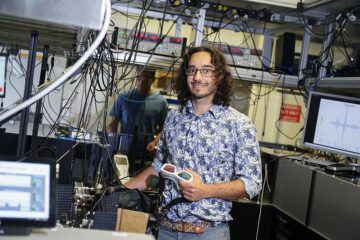Plant diversity increases insect diversity

In the BEF-China experiment, tree species richness varies across different subplots. Helge Bruelheide
“Our results make it clear that developments such as the currently observed insect decline can be linked to the way in which we humans manage the ecosystems we use,” says lead author Prof Andreas Schuldt from the University of Göttingen, previously with the German Centre for Integrative Biodiversity Research (iDiv).
Together with his co-authors, Schuldt evaluated extensive data on plant and insect diversity from two of the world’s largest biodiversity experiments: the Jena Experiment and BEF-China.
In the first experiment, the number of plant species in a grassland was altered and in the second, the number of tree species in a forest. Both experiments were designed to investigate the effects of plant diversity on other organisms and the functioning of the respective ecosystem.
The data show that a reduction in plant species richness (number of species) caused by, for example, the intensive use of agricultural and forest land, can lead to reduced insect abundance (number of individuals), which in turn reduces insect species richness.
“It is important to note that it is not only the loss of plant species alone which is crucial, but also the associated loss of structural diversity,” says Jena Experiment speaker and senior author Prof Nico Eisenhauer from the iDiv research centre and Leipzig University.
“These results show that we can make a significant contribution to the protection of biodiversity through structure-enhancing measures such as adapted mowing times and the preservation of old trees,” adds BEF-China speaker Prof Helge Bruelheide from the Martin Luther University Halle-Wittenberg and iDiv.
The comparison of data from widely differing habitats shows the relevance of these research results for key ecosystems used by humans. The study was made possible by extensive funding from the Deutsche Forschungsgemeinschaft (DFG).
Prof Andreas Schuldt
Department Waldnaturschutz
University of Göttingen
Phone: +49-341 9733232
Email: andreas.schuldt@forst.uni-goettingen.de
Prof Nico Eisenhauer
Head of the research group Experimental Interaction Ecology
German Centre of Integrative Biodiversity Research (iDiv) Halle-Jena-Leipzig
Leipzig University
Email: nico.eisenhauer@idiv.de
Prof Helge Bruelheide
Professor for Geobotany
Martin Luther University Halle-Wittenberg
Co-Director of the
German Centre for Integrative Biodiversity Research (iDiv) Halle-Jena-Leipzig
Phone: +49-345 5526222
Email: helge.bruelheide@botanik.uni-halle.de
Schuldt A, Ebeling A, Kunz M, Staab M, Guimarães-Steinicke C, Bachmann D, Buchmann N, Durka W, Fichtner A, Fornoff F, Härdtle W, Hertzog L, Klein AM, Roscher C, Schaller J, von Oheimb G, Weigelt A, Weisser W, Wirth C, Zhang J, Bruelheide H, Eisenhauer N (2019) Multiple plant diversity components drive consumer communities across ecosystems. Nature Communications DOI: https://doi.org/10.1038/s41467-019-09448-8
https://www.idiv.de/en/news/news_single_view/news_article/plant_divers-2.html
Media Contact
Alle Nachrichten aus der Kategorie: Biowissenschaften Chemie
Der innovations-report bietet im Bereich der "Life Sciences" Berichte und Artikel über Anwendungen und wissenschaftliche Erkenntnisse der modernen Biologie, der Chemie und der Humanmedizin.
Unter anderem finden Sie Wissenswertes aus den Teilbereichen: Bakteriologie, Biochemie, Bionik, Bioinformatik, Biophysik, Biotechnologie, Genetik, Geobotanik, Humanbiologie, Meeresbiologie, Mikrobiologie, Molekularbiologie, Zellbiologie, Zoologie, Bioanorganische Chemie, Mikrochemie und Umweltchemie.
Neueste Beiträge

Neue universelle lichtbasierte Technik zur Kontrolle der Talpolarisation
Ein internationales Forscherteam berichtet in Nature über eine neue Methode, mit der zum ersten Mal die Talpolarisation in zentrosymmetrischen Bulk-Materialien auf eine nicht materialspezifische Weise erreicht wird. Diese „universelle Technik“…

Tumorzellen hebeln das Immunsystem früh aus
Neu entdeckter Mechanismus könnte Krebs-Immuntherapien deutlich verbessern. Tumore verhindern aktiv, dass sich Immunantworten durch sogenannte zytotoxische T-Zellen bilden, die den Krebs bekämpfen könnten. Wie das genau geschieht, beschreiben jetzt erstmals…

Immunzellen in den Startlöchern: „Allzeit bereit“ ist harte Arbeit
Wenn Krankheitserreger in den Körper eindringen, muss das Immunsystem sofort reagieren und eine Infektion verhindern oder eindämmen. Doch wie halten sich unsere Abwehrzellen bereit, wenn kein Angreifer in Sicht ist?…





















